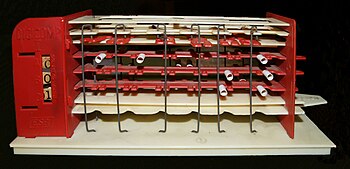Digi-Comp I: Difference between revisions
Arithmeticon (talk | contribs) m Removed "more citations needed" template (from 2014) - citations now sufficient |
|||
| Line 1: | Line 1: | ||
[[Image:Digicomp I.JPG|thumb|350px|The original DigiComp I]] |
[[Image:Digicomp I.JPG|thumb|350px|The original DigiComp I]] |
||
The '''Digi-Comp I''' |
The '''Digi-Comp I''' is a functioning, mechanical digital [[computer]] sold in kit form. It was originally manufactured from [[polystyrene]] parts by [[E.S.R., Inc.]] starting in 1963 and sold as an educational toy for US$4.99 ({{Inflation|US|4.99|1963|fmt=eq|cursign=US$}}).<ref name="Ad for Digi Comp I">{{cite web|url=https://www.syssrc.com/digicomp_I_Ad.png|title=Electronic Computer Brain|archive-url=https://web.archive.org/web/20171211190059/https://www.syssrc.com/digicomp_I_Ad.png|archive-date=2017-12-11}}</ref> |
||
The Digi-Comp I has been referred to as the first home computer.<ref>{{Cite journal |last=Winkless |first=Nelson |date=November 1984 |title=The First Home Computer |journal=Creative Computing |pages=12}}</ref> |
The Digi-Comp I has been referred to as the first home computer.<ref>{{Cite journal |last=Winkless |first=Nelson |date=November 1984 |title=The First Home Computer |journal=Creative Computing |pages=12}}</ref> |
||
A successor, the [[Digi-Comp II]], |
A successor, the [[Digi-Comp II]], is not programmable, but in effect a visible calculator. A two-level [[Masonite]] platform with guides serves as the medium for a supply of marbles that rolled down an inclined plane, moving plastic cams as they fell.<ref name="FODC2077">{{cite web|url=http://tech.groups.yahoo.com/group/friendsofdigicomp/message/2077 |archive-url=https://archive.today/20130630172025/http://tech.groups.yahoo.com/group/friendsofdigicomp/message/2077 |url-status=dead |archive-date=June 30, 2013 |title=Yahoo friendsofdigicomp |date= |accessdate=2013-04-17}}</ref> |
||
==Operation== |
==Operation== |
||
The Digi-Comp I |
The Digi-Comp I contains three mechanical [[Flip-flop (electronics)|flip-flops]], providing an ability to connect them together in a programmable way using thin vertical wires that are either pushed, or blocked from moving, by a number of cylindrical pegs. The whole arrangement is "clocked" by moving a lever back and forth. Different configurations of these cylinders cause the Digi-Comp to compute different [[Boolean logic]] operations. With a three binary digit (3-bit) readout of the state of the flip-flops, it could be programmed to demonstrate binary logic, to perform various operations such as addition and subtraction, and to play some simple logic games such as [[Nim]].<ref>{{cite web|last1=Woodhouse|first1=Trevor|title=K'nex Computer|url=https://www.youtube.com/watch?v=jkUd9rYkYnA |archive-url=https://ghostarchive.org/varchive/youtube/20211221/jkUd9rYkYnA |archive-date=2021-12-21 |url-status=live|website=YouTube|publisher=Trevor Woodhouse|accessdate=2015-11-15}}{{cbignore}}</ref> |
||
Although promotional materials described it as an "actual working digital computer," |
Although promotional materials described it as an "actual working digital computer," |
||
Latest revision as of 10:45, 21 December 2024

The Digi-Comp I is a functioning, mechanical digital computer sold in kit form. It was originally manufactured from polystyrene parts by E.S.R., Inc. starting in 1963 and sold as an educational toy for US$4.99 (equivalent to US$50 in 2023).[1]
The Digi-Comp I has been referred to as the first home computer.[2]
A successor, the Digi-Comp II, is not programmable, but in effect a visible calculator. A two-level Masonite platform with guides serves as the medium for a supply of marbles that rolled down an inclined plane, moving plastic cams as they fell.[3]
Operation
The Digi-Comp I contains three mechanical flip-flops, providing an ability to connect them together in a programmable way using thin vertical wires that are either pushed, or blocked from moving, by a number of cylindrical pegs. The whole arrangement is "clocked" by moving a lever back and forth. Different configurations of these cylinders cause the Digi-Comp to compute different Boolean logic operations. With a three binary digit (3-bit) readout of the state of the flip-flops, it could be programmed to demonstrate binary logic, to perform various operations such as addition and subtraction, and to play some simple logic games such as Nim.[4]
Although promotional materials described it as an "actual working digital computer," the device is more accurately described as a finite-state machine, one of the underpinning concepts used to build computers.
Reproductions
Starting in 2005, Minds-On Toys has made available the Digi-Comp I version 2.0 as a relatively inexpensive binder's board version of the original Digi-Comp, albeit with a much enhanced instruction manual.[5]
See also
- Dr. Nim - game based on the computer
- Geniac
- WDR paper computer
- CARDboard Illustrative Aid to Computation
- Turing Tumble, a 2019 mechanical computer inspired by it
- Robert C. Martin, who credits playing with this toy at the age of 12 as being what made him decide to become a programmer for the rest of his life.[6]
- Little man computer
References
- ^ "Electronic Computer Brain". Archived from the original on 2017-12-11.
- ^ Winkless, Nelson (November 1984). "The First Home Computer". Creative Computing: 12.
- ^ "Yahoo friendsofdigicomp". Archived from the original on June 30, 2013. Retrieved 2013-04-17.
- ^ Woodhouse, Trevor. "K'nex Computer". YouTube. Trevor Woodhouse. Archived from the original on 2021-12-21. Retrieved 2015-11-15.
- ^ "Minds-On Toys - Kits". Retrieved 2013-04-17.
- ^ Clean Code - Uncle Bob / Lesson 5, archived from the original on 2021-12-21, retrieved 2021-06-23
External links
- The Old Computer Museum - Collection of old analog, digital and mechanical computers
- Friends of Digi-Comp - Discussion of this toy. Images, links, manuals and programming information
- Digi-Comp I v2.0 - Online vendor of working replica kit; historical details
- Digi-Comp I Emulator - Emulator for the original Digi-Comp I written in JavaScript

